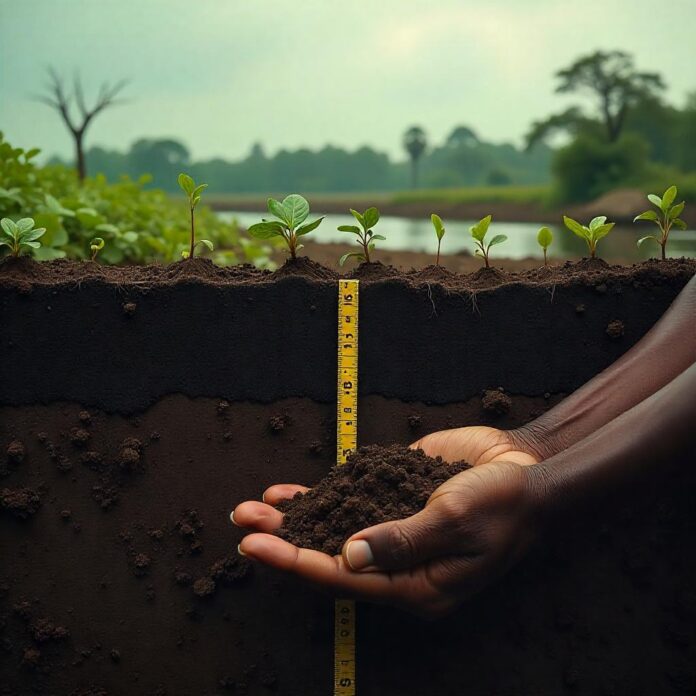The Niger Delta—once a tapestry of lush mangroves, fertile farmlands, and vibrant aquatic ecosystems—now epitomizes a global ecological livelihood crisis. Recent scientific studies reveal a chilling reality: crude oil has seeped 5 meters deep into farmlands and waterways, creating a vertical column of toxicity that poisons roots, groundwater, and hope. This contamination is not superficial; it infiltrates the very foundations of subsistence farming and fishing, threatening 30 million people across 40 ethnic groups whose identities are intertwined with the land and water. As Shell divests its onshore assets without cleanup commitments, this crisis escalates from environmental tragedy to systemic cultural collapse.
Unfolding Contamination: How 5-Meter Toxicity Invades Ecosystems
Advanced satellite radar data analysis has documented unreported spills penetrating 5 meters into soil profiles across 9,000 km² of the Niger Delta. This depth allows toxins to bypass natural attenuation, reaching aquifers and creating long-term reservoirs of pollution. Annual mangrove forest mortality rates have reached 5,644 hectares—equivalent to 28 soccer fields disappearing daily. During dry seasons, oil sinks deeper into cracked soil, destroying root systems. Rainy seasons spread contamination horizontally through floods, contaminating new farmlands and fisheries. Acid rain from gas flaring accelerates metal leaching into soils, releasing carcinogens like benzene and naphthalene. Staple crops absorb these toxins; cassava tubers accumulate polycyclic aromatic hydrocarbons, reducing protein content by 40%, while yam seedlings fail entirely in 70% of spill-affected areas due to disruption of nitrogen-fixing soil bacteria.
Agricultural Devastation: Farming in the Shadow of Poison
Generations of farmers now face barren lands where bounty once flourished. A farmer from Eleme recalls pre-spill yam tubers reaching three feet long. Today, clearing an entire acre yields just four bags of cassava—a 90% productivity drop. Ant infestations, attracted by chemical changes in oil-soaked soil, devour remaining crops. Indigenous food systems have collapsed: Cocoyam, once a cultural delicacy smoked with catfish, has vanished from Otuasega communities. Plantain blight linked to lead contamination affects 85% of groves. Moonfish and tilapia populations have declined by 70%, while surviving catfish reek of crude, rendering them inedible. Economic ruin follows ecological destruction; fishers who earned ₦80,000 daily now face zero income after spills destroy nets and boats. Replacement costs of ₦500,000 exceed annual earnings, trapping families in irreversible debt.
Vanishing Foodways: Cultural Erosion in Oil-Soaked Soil
Rituals binding generations are disappearing alongside harvests. Yam festivals celebrating abundance and fish dances have ceased in 92% of Ogoni communities, fracturing social cohesion and intergenerational knowledge transfer. Women bear disproportionate impacts, with shellfish gatherers reporting 98% depletion of crabs and oysters—once critical income sources. Seventy percent now rely on firewood sales, earning ₦2,000 daily versus ₦15,000 previously. Traditional diets like garri (fermented cassava) with banga soup are displaced by imported rice and noodles distributed as “relief” by oil companies, worsening malnutrition. Childhood stunting rates exceed 40% in oil zones, severing connections between land, food, and cultural identity that sustained communities for centuries.
Bodily Invasion: Toxins in the Human Bloodstream
Hydrocarbon levels in blood samples from Akwa Ibom residents reach 8,000 times World Health Organization limits, while lead concentrations trigger kidney failure. Women in contaminated zones suffer premature births and postpartum hemorrhage at triple the national rate due to endocrine disruption. Beyond physical poisoning, 89% of residents exhibit “environmental distress syndrome”—chronic anxiety, rumination, and helplessness fueled by constant hypervigilance about pipeline explosions. Chromium-DNA adducts detected in umbilical cords confirm genotoxic risks for future generations, with infant mortality doubling when mothers live near spills pre-conception. Benzene from gas flaring causes leukemia risk, polycyclic aromatic hydrocarbons drive skin and lung cancers, while lead induces neurodegenerative diseases and mercury from artisanal refining causes kidney failure and motor impairment.
Accountability Vacuum: Corporate Exit and Institutional Failure
Shell’s 2025 sale of operations included a $2.5 billion loan for asset transfer—with zero funds allocated for remediation, violating Nigerian liability laws. The $1 billion Ogoni restoration project contaminated new areas through improper toxic soil storage; of 41 contractors hired, 21 had no environmental remediation experience, while laboratories falsified contamination tests. Despite Dutch court rulings ordering €15 million compensation for Goi and Oruma farmers, cases languish for 13+ years as community plaintiffs face intimidation. Chiefs accepting bribes of “noodles” silence dissent, while military presence protects pipeline corridors. Joint Investigation Visits meant to determine spill causes remain unpublished since 2022, shielding corporations from scrutiny as Renaissance Africa assumes control without cleanup obligations.
Reclaiming Life: Pathways Through Toxicity
Radical remediation offers glimmers of hope. Mycoremediation pilots deploy oyster mushrooms to degrade polycyclic aromatic hydrocarbons at one-fifth the cost of mechanical methods. Mangrove DNA banking preserves Rhizophora racemosa genetics for post-cleanup replanting. Policy interventions could mandate cleanup bonds before divestment approvals, modeled on Alaska’s Oil Pollution Act. Community-Led Joint Investigation Visits using citizen science water testing kits could replace corporate-dominated assessments. Economic transitions include solar-powered cassava hubs processing uncontaminated crops into garri for urban markets, and eco-tourism showcasing mangrove restoration trails. Women’s collectives have already planted 2.6 million mangrove sprigs, while youth demand bioremediation jobs as alternatives to destructive practices.
The 5-meter toxicity plaguing the Niger Delta measures more than physical depth—it quantifies ecological betrayal, cultural erasure, and institutional abandonment. Yet within this crisis lies fierce resilience: smartphone-documented spills, women replanting mangroves sprig by sprig, communities demanding accountability. As corporations exit, global pressure must compel Renaissance to fund the $12 billion cleanup Bayelsa alone requires. Restoring this land transcends technical remediation; it constitutes ecological justice—honoring the yam festivals, moonfish harvests, and generations refusing to let their identity become another spill casualty.


